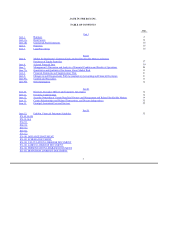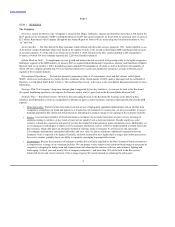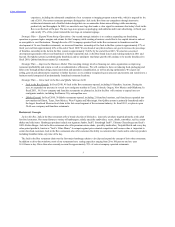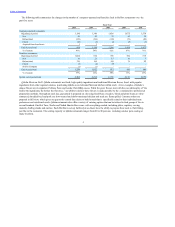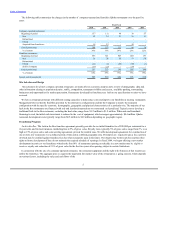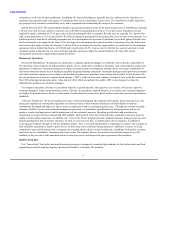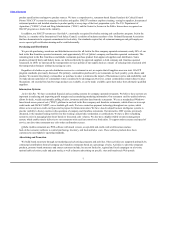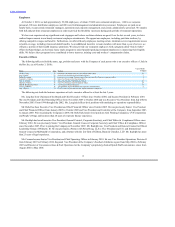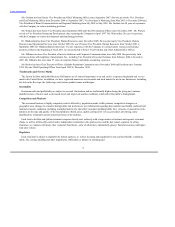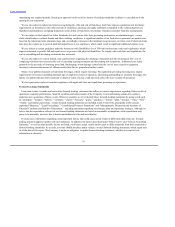Jack In The Box 2010 Annual Report Download - page 12
Download and view the complete annual report
Please find page 12 of the 2010 Jack In The Box annual report below. You can navigate through the pages in the report by either clicking on the pages listed below, or by using the keyword search tool below to find specific information within the annual report.
Table of Contents
ITEM 1A. RISK FACTORS
We caution you that our business and operations are subject to a number of risks and uncertainties. The factors listed below are
important factors that could cause actual results to differ materially from our historical results and from projections in forward-looking
statements contained in this report, in our other filings with the Securities and Exchange Commission (“SEC”), in our news releases and
in oral statements by our representatives. However, other factors that we do not anticipate or that we do not consider significant based on
currently available information may also have an adverse effect on our results.
Food service businesses may be materially and adversely affected by changes in
consumer tastes, national and regional economic and political conditions, and changes in consumer eating habits, whether based on new
information regarding diet, nutrition and health, or otherwise. Recessionary economic conditions, including higher levels of
unemployment, lower levels of consumer confidence and decreased consumer spending can reduce restaurant traffic and sales and impose
practical limits on pricing. If recessionary economic conditions persist for an extended period of time, consumers may make long-lasting
changes to their spending behavior. The performance of individual restaurants may be adversely affected by factors such as traffic
patterns, demographics and the type, number and location of competing restaurants, as well as local regulatory, economic and political
conditions, terrorist acts or government responses, and catastrophic events such as earthquakes or other natural disasters.
Multi-unit food service businesses such as ours can also be materially and adversely affected by widespread negative publicity of any
type, particularly regarding food quality, nutritional content, illness or public health issues (such as epidemics or the prospect of a
pandemic), obesity, safety, injury or other health concerns. Adverse publicity in these areas could damage the trust customers place in our
brand. We have taken steps to mitigate each of these risks. To minimize the risk of foodborne illness, we have implemented a HACCP
system for managing food safety and quality. Nevertheless, these risks cannot be completely eliminated. Any outbreak of such illness
attributed to our restaurants or within the food service industry or any widespread negative publicity regarding our brands or the
restaurant industry in general could cause a decline in our sales and have a material adverse effect on our financial condition and results
of operations.
Unfavorable trends or developments concerning factors such as inflation, increased cost of food, labor, fuel, utilities, technology,
insurance and employee benefits (including increases in hourly wages, workers’ compensation and other insurance costs and premiums),
increases in the number and locations of competing restaurants, regional weather conditions and the availability of qualified, experienced
management and hourly employees, may also adversely affect the food service industry in general. Because a significant number of our
restaurants are company-operated, we may have greater exposure to operating cost issues than chains that are more heavily franchised.
Exposure to these fluctuating costs, including increases in commodity costs, could negatively impact our margins. Our continued success
will depend in part on our ability to anticipate, identify and respond to changing conditions.
Restaurant sales and profitability are traditionally higher in the spring and summer months due to increased travel, improved weather
conditions and other factors which affect the public’s dining habits. We cannot assure that our operating results will not be impacted by
seasonal fluctuations in sales.
Foodservice businesses such as ours can be materially and
adversely affected by severe weather conditions. Severe storms, hurricanes, prolonged drought or protracted heat waves and their
aftermath, including flooding, mudslides or wildfires, can result in (i) lost restaurant sales when consumers stay home or are physically
prevented from reaching the restaurants; (ii) property damage and lost sales when locations are forced to close for extended periods of
time; (iii) interruptions in supply when vendors suffer damages or transportation is affected and (iv) increased costs if agricultural
capacity is diminished or if insurance recoveries do not cover all our losses. If systemic or widespread adverse changes in climate or
weather patterns occur, we could experience more of these losses, and such losses could have a material effect on our results of operations
and financial condition.
Dependence on frequent deliveries of fresh produce and other food products subjects food service
businesses such as ours to the risk that shortages or interruptions in supply could adversely affect the availability, quality and cost of
ingredients or require us to incur additional costs to obtain adequate
11


